How to Learn Anatomy in Medical School with Anki7 min read
What anatomy do I need to know for my school’s exams? What anatomy do I need to know for Step 1? In this post, I’ll take you through two Anki decks that have helped me understand anatomy in medical school, perform well on anatomy practicals, and prepare for Step 1.
Disclaimer: this is not a replacement for the Cadaver Lab! If your school has a physical cadaver lab use it as much as you can. Actually handling and seeing the dissected human body is an amazing opportunity and a gift. I’m missing it dearly during this pandemic (the post was written on 11/6/2020).
My priority for Step 1 would be AnKing > 100 Concepts >>>>>> Michigan
My priority for your in-house exams would be Michigan >> 100 concepts > AnKing
Michigan Deck + Questions
Link: https://www.reddit.com/r/medicalschoolanki/comments/g4j4o9/a_complete_umich_cadaver_deck/
This is going to be your “school-specific” beast. The Michigan Anki deck is huge but has fantastic pictures and image occlusions. This is as close as it will look to what you see in the Anatomy lab.
So how do you study for your exams using this deck? All medical schools should give you a structure list you need to know, for example, this is the first 1/4th of the list from the University of Michigan on Back and Spinal cord. Just the first 1/4th…
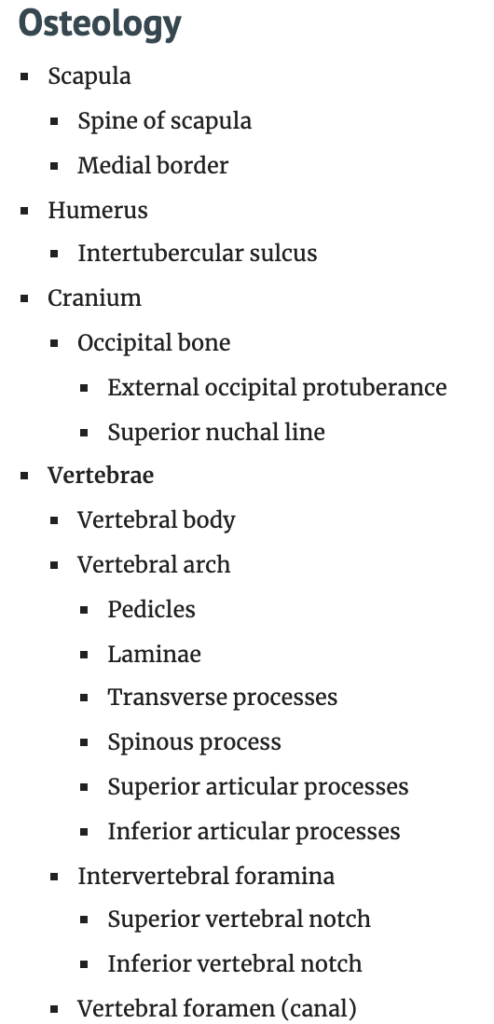
So what I would do the day before I go into the anatomy lab, or, in dire times, two/three days before my practical exam, is search through the Michigan deck for these structures, unsuspend those cards, and learn them.
The only painful thing here is the search bar won’t work as this deck is tagged broadly to groups. Don’t try searching the bones or muscles as they won’t show up. You need to go to the sidebar, where each section is tagged, and search through it.
Whenever you find a relevant structure, unsuspend that card.
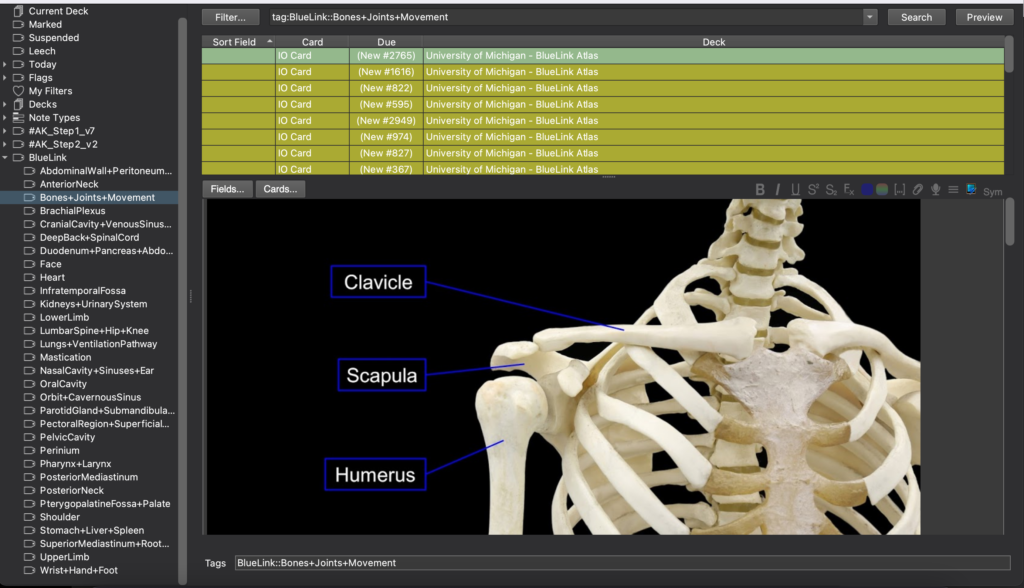
The next thing I highly recommend is the University of Michigan anatomy questions. If you do all of these questions and understand them, it will be very hard for you to do poorly on your school’s anatomy exam (or it should be).
Finally, once you take your exam, re-suspend these cards. They are low-yield for Step 1.
Bottom Line: Study the structures you need to know for your school from the University of Michigan Anki deck. Then do the Michigan questions for those anatomy sections for your school’s practical anatomy exams.
AnKing
I love the AnKing. If you don’t know about it you can check out my setup guide here, and how I use it to study daily in medical school here.
In regards to anatomy, however, the AnKing still is great. Just go through your lectures and third-party content and unsuspend as you normally do and the AnKing’s anatomy will pop-up throughout.
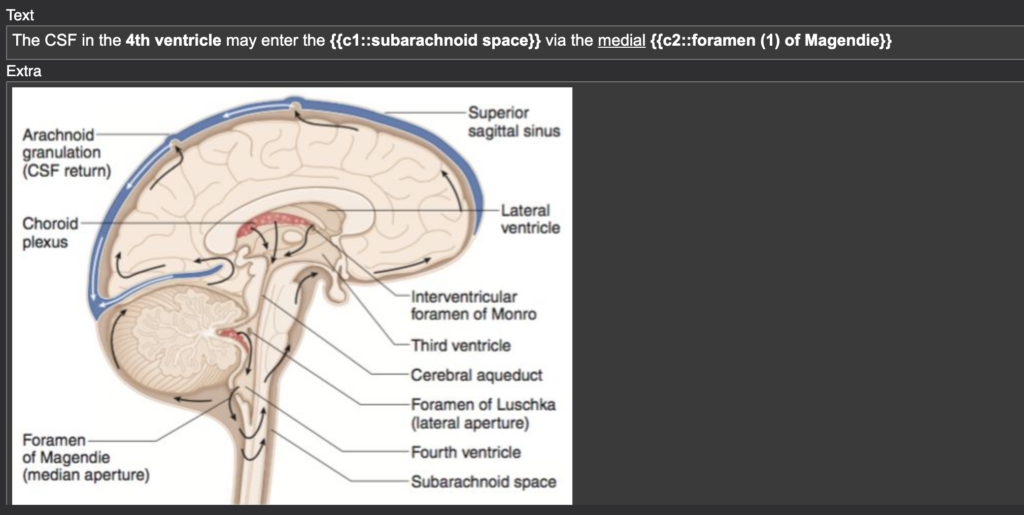
As a double-check I usually scroll through the Zanki subdeck I am currently on (go to deck browser and not tag browser, “AnKing” -> “Zanki Step Decks” -> Specific Deck). I do this to make sure I am not missing any relevant content at the end of very week. If I did anatomy that week my perusing will include looking for anatomy cards. I would sort by date created before you look.
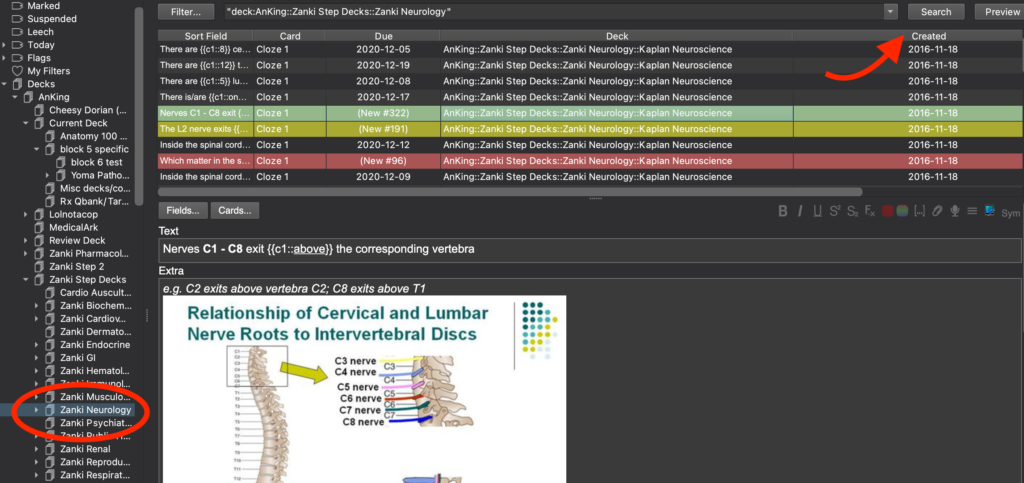
However, I found AnKing severely lacking when it comes to my school’s practical anatomy exams and some Step 1 anatomy information.
You will not do well on your school’s practical exam if you just use the AnKing. You need to supplement it with other resources like the Michigan anatomy deck.
Bottom Line: After learning some section of Anatomy at your school, scroll through that Zanki subdeck, by date created, and unsuspend any anatomy relevant cards.
100 Concepts Anatomy
Link: https://www.reddit.com/r/medicalschoolanki/comments/wah7do/100_concepts_anatomy_with_media/
Whatever the AnKing missed in regards to Step 1-relevant anatomy the 100 concepts anatomy deck fills in. This is a small deck with only 300 cards.
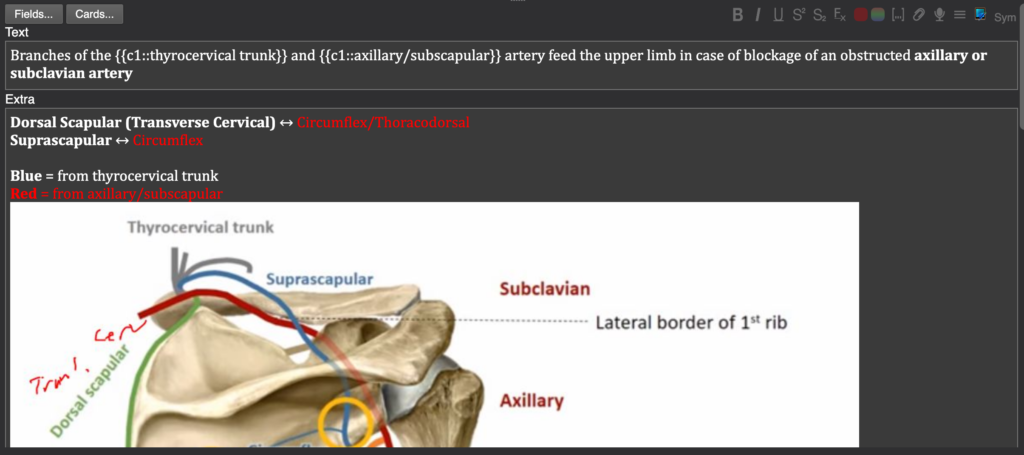
How I would use it is after we learned something in an anatomy lecture or the anatomy lab I would scroll through this deck until I found the relevant content and unsuspend and learn those cards. Sort by date created as they are created in a logical order.

Yes, there might be the occasional overlap with the AnKing deck. You don’t need to worry about it though, this is only 300 cards, it will make a negligible difference in your daily card count. If you really think you are seeing content redundantly just use the search function and suspend the card if there is overlap.
Bottom Line: After learning anatomy go to the 100 Concepts deck and unsuspend the relevant information. Don’t worry about the overlap with the AnKing deck.
Summary
So how would I use all of this together? In an ideal world, before the cadaver lab, I would learn all of the structures from the Michigan Anki deck and learn all the rest of the information about these structures from AnKing and the 100 Concepts deck. Then, come exam time, I have been reviewing continuously with the Anki algorithm anyway so I know this information.
Medical school is not the ideal world. I do not have time to go through and memorize the structures during the regular week, I just couldn’t do it. What I ended up doing, that worked, was to learn the AnKing information and 100 Concepts cards’ information during regular school weeks. Then, cram the Michigan Anatomy Anki information the day or two before the exam. I know this goes against everything Anki is meant for but I only need this information, for now, for this one specific practical exam. The AnKing and 100 concepts information I will need for Step 1.
Then, after I take the practical exam, I resuspend the Michigan cards. The information is too low-yield to add to my daily card count.
The University of Michigan Anki deck will help you crush your in-house anatomy practical exams, but after the practical re-suspend those cards.
In regards to clinically-oriented questions, the AnKing should be able to hold you over along with the Michigan practice questions.
Finally, for Step1, the 100 Concepts deck will fill the few anatomy blanks AnKing has.
Happy studying!
-Zach
Bottom Bottom Line: Learn the AnKing information and 100 Concepts cards’ information during regular school weeks. Then, cram the Michigan Anatomy Anki information the day or two before the exam. Use the physical cadaver as much as you can if you have access to one.
9 Comments
maryam · February 12, 2022 at 5:45 am
Zach! This was so helpful. Thank you so much, really appreciate this.
Thomad · June 6, 2022 at 11:03 pm
Hello Zack,
I just recently found your YouTube channel and have to say it’s really great.
I am a medical student in Germany and I am trying to find the right learning strategy for me. I have not yet found a deck that makes learning easier for me.
In your YouTube videos you talked about Anki and I think the app is really great. I have the problem that I do not know how best to generate the cards.
Do you create cards like the type
“Mixing {{c1::blue}} and {{c2::yellow}} results in {{c3::green}}”
Or
“What 2 colors need to be mixed to make green?”
Which do you think is better?
Greetings thomas
Zach · June 18, 2022 at 7:38 pm
100% “Mixing {{c1::blue}} and {{c2::yellow}} results in {{c3::green}}” is the best option.
Tansi · May 31, 2023 at 6:22 am
Thanks a lot zach.
I must attest, you make learning seem so easy.
watching your youtube videos is deeply inspiring
Godblesszach
Zach · June 4, 2023 at 7:51 pm
Thanks for the nice words! Keep going.
Amaan · January 9, 2025 at 12:59 pm
This seems like a good plan. I am just beginning anatomy in med school, outside the USA with the plan to take step 1 at some point. Could you kindly link to the best version of the 100 concepts anki deck as this link doesn’t work. Thanks!
Zach · March 14, 2025 at 3:00 pm
I think I fixed the link? Do the downloads on this page work? https://www.reddit.com/r/medicalschoolanki/comments/wah7do/100_concepts_anatomy_with_media/
Amaan · January 9, 2025 at 2:11 pm
Never mind, I actually did find the latest version of 100 concepts anki on ankihub. But for the Michigan deck, there are 2 versions. The original and then a searchable one. Neither of which however work great for picking cards out. Do you literally have to go through all 2000+ cards regularly and choose just the ones you need? Also in the browser it shows all the labels apart from the relevant one but in Anki when doing the card it only shows the one that is the answer.
Zach · March 14, 2025 at 2:59 pm
I would search the names of the muscles or bones or whatever and then unsuspend that way.